Southern California Edison says its analysis confirms that it would be safe to fire up the nuclear plant’s Unit 2 reactor, but as a precautionary move it is proposing running it at only 70%. Yet it also suggests that running San Onofre at 100 percent for 11 months would present a strong possibility of a tube rupture resulting in a catastrophic release of radiation into the environment.
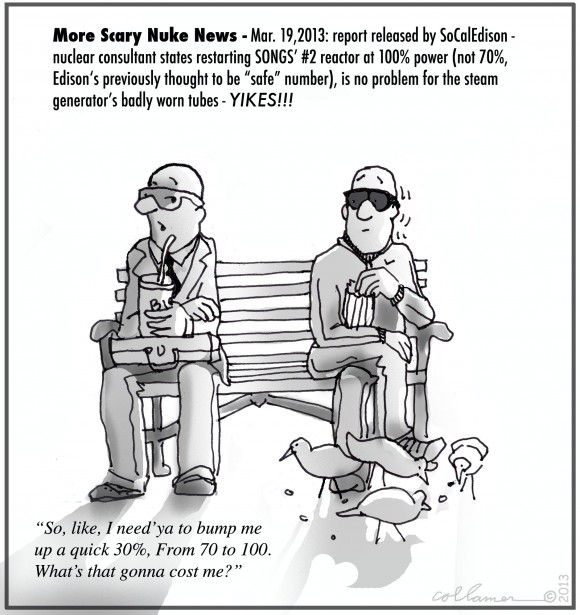

Report: Running San Onofre nuke plant at full power could cause breakdown after 11 months
By Michael R. Blood, Associated Press
LOS ANGELES — The troubled San Onofre nuclear power plant in California could be restarted safely and run at full power, but the risk of a breakdown would increase to vexing levels after 11 months, a report concluded Monday.
The seaside plant between San Diego and Los Angeles hasn’t produced electricity since January 2012, when a tiny radiation leak led to the discovery of unusual damage to hundreds of steam generator tubes that carry radioactive water. A consultant’s study prepared for operator Southern California Edison represented an attempt to answer federal regulators who are considering Edison’s proposal to restart one reactor, Unit 2.
Gary Headrick from San Clemente Green: Edison’s ability to accurately predict the future: Four new steam generators had a design flaw that underestimated the extreme forces in the system by 400% and failed in less than two years instead of forty. They also predicted massive blackouts if they went off line, especially during the summer, but the lights are still on more than a year later.
The restart blueprint calls for a trial run at reduced power, but Nuclear Regulatory Commission staff wanted Edison to show generator tubes don’t break during “the full range” of conditions, including at full power. That appeared to raise an obstacle to the proposed restart. The NRC said it wanted the company to demonstrate that Unit 2 could meet that threshold, or explain how generator tubes would interact with each other if the plant is operating at maximum capacity.
The report found the plant could hit the full-power mark but it would be too risky to remain at that level for more than 11 months because of possible damage to tubing. Edison concluded last year that tube damage could be slowed or stopped by limiting the plant to 70 percent power.
“This evaluation confirms the structural integrity of the Unit 2 steam generators at 100 percent power, as requested by the NRC,” SCE’s chief nuclear officer, Peter Dietrich, said in a statement. “While we have no intent to restart Unit 2 at full power, this demonstrates the amount of safety margin we have built into our analyses. We welcome this additional safety analysis but remain steadfast in our commitment to restart Unit 2 at only 70 percent power.”
The report projected that even at 70 percent power, the risk of a tube break would increase to an unacceptable level after about a year-and-a-half. Those calculations were based on conditions in its sister, Unit 3, where tube damage was more extensive. Edison spokeswoman Jennifer Manfre said the company used the Unit 3 benchmark to be as conservative as possible when determining safety margins.
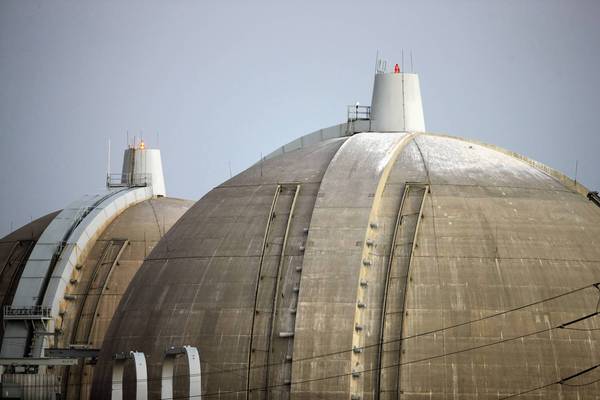

The report comes several weeks after Edison argued, in a separate filing, that 70 percent is, in essence, full power for the five-month trial run. Under its restart proposal, full power “is 70 percent for the proposed operating period” and meets the federal requirements, the company wrote at the time.
The bill for replacement power, tests and repairs tied to San Onofre topped $400 million last year.
Meanwhile, state regulators are determining if ratepayers should be hit with costs tied to the shutdown, the NRC’s investigative arm is looking into information Edison provided to the agency on the generators and environmental activists are pressing to have the plant shut down permanently. Opponents of the restart warned that the report highlighted looming trouble. They have long argued that Edison should have sought an amendment to its operating license because of design changes in the generators, a process that could take up to two years.
“For a year Edison has said the steam generators were defectively designed, couldn’t operate at full power and power must be restricted to 70 percent,” said Daniel Hirsch, a lecturer on nuclear policy at the University of California, Santa Cruz, and a critic of the nuclear power industry. “Edison has suddenly reversed course and now says it is safe to run at 100 percent,” Hirsch said. “If it were safe, they wouldn’t have to twist logic into a pretzel to try to claim they can run at 100 percent power after a year of claiming they can’t.”
John Large, a consultant for Friends of the Earth, an advocacy group challenging the restart, said the report amounted to a prediction “that the plant will progressively destroy itself.” Large, a nuclear engineer, said, “There remain enormous uncertainties with predicting tube wear and this report is not convincing that they know enough to allow restart.”



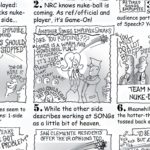

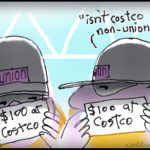
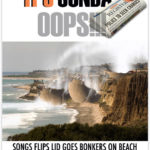






One would think that the Industry itself would be trying to “fact track” these safety improvements rather than waiting to see how they can getaway with spending less of their ratepayers money when the cost of a Fukushima is a Trillion Dollar Eco-Disaster, which the Country and the Industry cannot afford!
For all those in Nuclear Denial* that think a Trillion Dollar Eco-Disaster is too high, check out what the latest French report says:
French Nuclear Disaster Scenario Was So Bad The Government Kept It Secret http://www.businessinsider.com/potential-cost-of-a-nuclear-accident-so-high-its-a-secret-2013-3
snip:
Catastrophic nuclear accidents, like Chernobyl in 1986 or Fukushima No. 1 in 2011, are, we’re incessantly told, very rare, and their probability of occurring infinitesimal.
But when they do occur, they get costly. So costly that the French government, when it came up with cost estimates for an accident in France, kept them secret.
But now the report was leaked to the French magazine, Le Journal de Dimanche. Turns out, the upper end of the cost spectrum of an accident at the nuclear power plant at Dampierre, in the Department of Loiret in north-central France, amounted to over three times the country’s GDP.
Hence, the need to keep it secret. The study was done in 2007 by the Institute for Radiological Protection and Nuclear Safety (IRSN), a government agency under joint authority of the Ministry of Defense and the Ministry of Environment, Industry, Research, and Health.With over 1,700 employees, it’s France’s “public service expert in nuclear and radiation risks.” This isn’t some overambitious, publicity-hungry think tank.
It evaluated a range of disaster scenarios that might occur at the Dampierre plant. In the best-case scenario, costs came to €760 billion—more than a third of France’s GDP. At the other end of the spectrum: €5.8 trillion! Over three times France’s GDP. A devastating amount. So large that France could not possibly deal with it.
Remember as of today: 1 Euro equals 1.29 US Dollars
* http://is.gd/XPjMd0
The illogical belief that Nature cannot destroy any land based nuclear reactor, any place anytime 24/7/365!
The NRC is wasting valuable time and money enabling SCE attempt to justify restarting their already damaged Unit 2 in a test mode to see what happens, instead of telling them to replace its defective poorly designed replacement steam generators!
This matter will not be “swept under the rug” since the safety of about 8 million people hangs in the balance of this 1.3 Billion Dollars debacle!
Note: The NRC just assessed San Onofre 2 & 3 “as needing to resolve one or two items of low safety significance,” WHICH IS A BAD NUCLEAR JOKE, considering Unit 3 has failed and can’t be operated!
http://www.nrc.gov/reading-rm/doc-collections/news/2013/13-013.pdf
San Onofre Unit 2 and Unit 3 have given the NRC (and the nuclear industry) a pair of BLACK EYES!
It is time for the NRC to restrict any restart discussion until every allegation has been answered completely and all 9,737 tubes of each steam generator have been inspected visually, using the most modern techniques for both external and internal fatigue/wear damage, which has not been done to date, instead SCE has used Bobbin-coil inspection methodology which is not as effective.
To help readers learn more about how Steam Generators (SG) can “fail” here is a link to an amazing accurate animation that was done to illustrate San Onofre’s Replacement Steam Generators (RSG) problems (which included MULTIPLE SG tube failures) and the animation even illustrates a Main Steam Line Break (MSLB):
http://www.acehoffman.org/sano/SanOnofreRSGsbyAceHoffman.swf
?Note: By scrolling over the animation a large number of additional animations can be viewed!
I think many readers are missing the point that San Onofre’s replacement steam generators (RSG) have MAJOR design flaws (Nuclear RSG Lemons), they now have more damage than the rest of the US nuclear “fleet” combined and one is less than a year old and the other is less than two years old!
Edison told ratepayers they would last 18+ years and save them over a Billion Dollars and now about two years later we have PAID 1.3 BILLION DOLLARS and are still paying 54 million dollars a month while Edison tries to figure out how to not get stuck with the bill!
Edison is trying to sell US a bridge, A Bridge To N? Energy!
I predict that time will show that a nuclear accident (not a nuclear incident) was narrowly avoided at SanO on January 31, 2012 only because of shear luck, due to the timing of the discovery of Edison’s poorly in-house designed replacement steam generators (RSG). Had that Unit 3 tube been just a tiny bit stronger and not leaked when it did; then with both Unit 2 & 3 back online, if a main steam line break or something similar occurred, we now know that it would have probably resulted in the complete venting of the core coolant within minutes, and we all know what that means…
SanO is now a 1.5 Billion Dollar RED FLAG that illustrates how easy NRC regulations can be gamed (without ANY enforcement penalties) which allow Utilities/Operators to make changes that have enormous implications to safety and the Public Health, with little to N? actual oversight, until it is to late!
The two basic problems at Fukushima, Japan were that:
(1) TEPCO’s regulator pushed too much paper instead of being “hands on”.
(2) TEPCO had total control over what data the public had access to, which prevented any real oversight by the public.
The USA cannot afford a Trillion Dollar Eco-Disaster like Fukushima, that is why the NRC needs to “overhaul” how it enforces its current regulations and develop new regulations ASAP to patch all the regulatory holes that now exist!
The first step is to really open up the entire NRC process to the public, so that true public oversight can take place, instead of the flawed system we now have, as SanO illustrates all too well! As it is now, the public does not have enough access to NRC documents, reports and/or data which prevents all knowledgable people from providing true input into the decision making process.
Or said another way, we cannot afford to have a Trillion Dollar Eco-Disaster in the USA for any reason and that includes GREED…
What we don’t know can indeed hurt US, especially if it is radioactive!
Pingback: Edison's Reef: A Not So Glowing Report | WilderUtopia.com